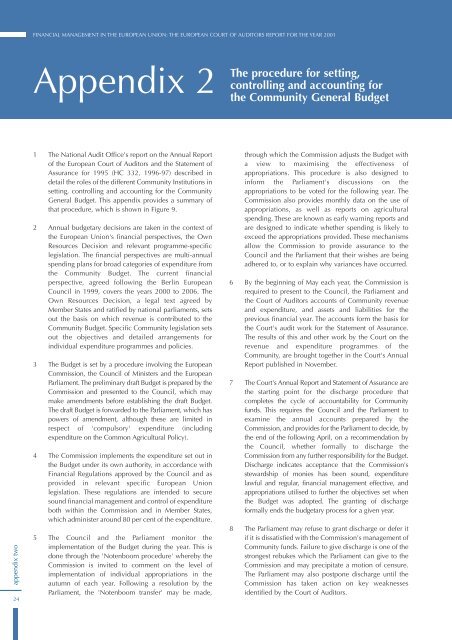Full report - National Audit Office
Full report - National Audit Office
Full report - National Audit Office
Create successful ePaper yourself
Turn your PDF publications into a flip-book with our unique Google optimized e-Paper software.
FINANCIAL MANAGEMENT IN THE EUROPEAN UNION: THE EUROPEAN COURT OF AUDITORS REPORT FOR THE YEAR 2001<br />
Appendix 2<br />
The procedure for setting,<br />
controlling and accounting for<br />
the Community General Budget<br />
appendix two<br />
24<br />
1 The <strong>National</strong> <strong>Audit</strong> <strong>Office</strong>'s <strong>report</strong> on the Annual Report<br />
of the European Court of <strong>Audit</strong>ors and the Statement of<br />
Assurance for 1995 (HC 332, 1996-97) described in<br />
detail the roles of the different Community Institutions in<br />
setting, controlling and accounting for the Community<br />
General Budget. This appendix provides a summary of<br />
that procedure, which is shown in Figure 9.<br />
2 Annual budgetary decisions are taken in the context of<br />
the European Union's financial perspectives, the Own<br />
Resources Decision and relevant programme-specific<br />
legislation. The financial perspectives are multi-annual<br />
spending plans for broad categories of expenditure from<br />
the Community Budget. The current financial<br />
perspective, agreed following the Berlin European<br />
Council in 1999, covers the years 2000 to 2006. The<br />
Own Resources Decision, a legal text agreed by<br />
Member States and ratified by national parliaments, sets<br />
out the basis on which revenue is contributed to the<br />
Community Budget. Specific Community legislation sets<br />
out the objectives and detailed arrangements for<br />
individual expenditure programmes and policies.<br />
3 The Budget is set by a procedure involving the European<br />
Commission, the Council of Ministers and the European<br />
Parliament. The preliminary draft Budget is prepared by the<br />
Commission and presented to the Council, which may<br />
make amendments before establishing the draft Budget.<br />
The draft Budget is forwarded to the Parliament, which has<br />
powers of amendment, although these are limited in<br />
respect of 'compulsory' expenditure (including<br />
expenditure on the Common Agricultural Policy).<br />
4 The Commission implements the expenditure set out in<br />
the Budget under its own authority, in accordance with<br />
Financial Regulations approved by the Council and as<br />
provided in relevant specific European Union<br />
legislation. These regulations are intended to secure<br />
sound financial management and control of expenditure<br />
both within the Commission and in Member States,<br />
which administer around 80 per cent of the expenditure.<br />
5 The Council and the Parliament monitor the<br />
implementation of the Budget during the year. This is<br />
done through the 'Notenboom procedure' whereby the<br />
Commission is invited to comment on the level of<br />
implementation of individual appropriations in the<br />
autumn of each year. Following a resolution by the<br />
Parliament, the 'Notenboom transfer' may be made,<br />
through which the Commission adjusts the Budget with<br />
a view to maximising the effectiveness of<br />
appropriations. This procedure is also designed to<br />
inform the Parliament's discussions on the<br />
appropriations to be voted for the following year. The<br />
Commission also provides monthly data on the use of<br />
appropriations, as well as <strong>report</strong>s on agricultural<br />
spending. These are known as early warning <strong>report</strong>s and<br />
are designed to indicate whether spending is likely to<br />
exceed the appropriations provided. These mechanisms<br />
allow the Commission to provide assurance to the<br />
Council and the Parliament that their wishes are being<br />
adhered to, or to explain why variances have occurred.<br />
6 By the beginning of May each year, the Commission is<br />
required to present to the Council, the Parliament and<br />
the Court of <strong>Audit</strong>ors accounts of Community revenue<br />
and expenditure, and assets and liabilities for the<br />
previous financial year. The accounts form the basis for<br />
the Court's audit work for the Statement of Assurance.<br />
The results of this and other work by the Court on the<br />
revenue and expenditure programmes of the<br />
Community, are brought together in the Court's Annual<br />
Report published in November.<br />
7 The Court's Annual Report and Statement of Assurance are<br />
the starting point for the discharge procedure that<br />
completes the cycle of accountability for Community<br />
funds. This requires the Council and the Parliament to<br />
examine the annual accounts prepared by the<br />
Commission, and provides for the Parliament to decide, by<br />
the end of the following April, on a recommendation by<br />
the Council, whether formally to discharge the<br />
Commission from any further responsibility for the Budget.<br />
Discharge indicates acceptance that the Commission's<br />
stewardship of monies has been sound, expenditure<br />
lawful and regular, financial management effective, and<br />
appropriations utilised to further the objectives set when<br />
the Budget was adopted. The granting of discharge<br />
formally ends the budgetary process for a given year.<br />
8 The Parliament may refuse to grant discharge or defer it<br />
if it is dissatisfied with the Commission's management of<br />
Community funds. Failure to give discharge is one of the<br />
strongest rebukes which the Parliament can give to the<br />
Commission and may precipitate a motion of censure.<br />
The Parliament may also postpone discharge until the<br />
Commission has taken action on key weaknesses<br />
identified by the Court of <strong>Audit</strong>ors.

















